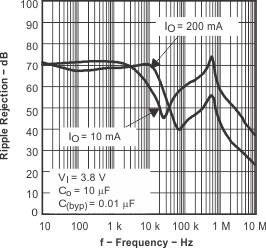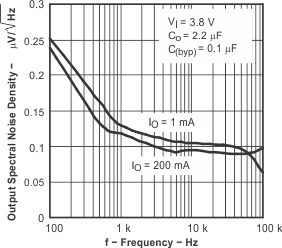SGLS162I April 2003 – March 2016 TPS793-Q1
PRODUCTION DATA.
- 1 Features
- 2 Applications
- 3 Description
- 4 Revision History
- 5 Voltage Options
- 6 Pin Configuration and Functions
- 7 Specifications
- 8 Detailed Description
- 9 Application and Implementation
- 10Power Supply Recommendations
- 11Layout
- 12Device and Documentation Support
- 13Mechanical, Packaging, and Orderable Information
Package Options
Mechanical Data (Package|Pins)
Thermal pad, mechanical data (Package|Pins)
Orderable Information
1 Features
- Qualified For Automotive Applications
- AEC-Q100 Qualified With the Following Results:
- Device Temperature Grade 1: –40°C to +125°C
- Device HBM ESD Classification Level 1C
- Device CDM ESD Classification Level C2
- 200-mA Low-Dropout Regulator With EN
- Available in 1.8-V, 2.5-V, 2.8-V, 3-V, 3.3-V, 4.75-V, and Adjustable Options
- High PSRR (70 dB at 10 kHz)
- Ultralow Noise (32 μV)
- Fast Start-Up Time (50 μs)
- Stable With a 2.2-μF Ceramic Capacitor
- Excellent Load and Line Transient
- Very Low Dropout Voltage
(112 mV at Full Load, TPS79330-Q1) - 5-Pin SOT-23 (DBV) Package
2 Applications
- VCOs
- RF
- Bluetooth™
3 Description
The TPS793xx-Q1 family of low-dropout (LDO) low-power linear voltage regulators features high power-supply rejection ratio (PSRR), ultralow noise, fast start-up, and excellent line and load transient responses in a small-outline SOT-23 package. Each TPS793-Q1 device in the family is stable, with a small 2.2-μF ceramic capacitor on the output. The TPS793xx-Q1 family uses an advanced, proprietary, BiCMOS fabrication process to yield extremely low dropout voltages (for example, 112 mV at 200 mA, TPS79330-Q1). Each device achieves fast start-up times (approximately 50 μs with a 0.001-μF bypass capacitor), while consuming very low quiescent current (170 μA typical). Moreover, when the device is placed in standby mode, the supply current is reduced to less than 1 μA. The TPS79328-Q1 exhibits approximately 32 μVRMS of output voltage noise with a 0.1-μF bypass capacitor. Applications with analog components that are noise sensitive, such as portable RF electronics, benefit from the high PSRR and low-noise features, as well as the fast response time.
Device Information(1)
| PART NUMBER | PACKAGE | BODY SIZE (NOM) |
|---|---|---|
| TPS793xx-Q1 | SOT-23 (6) | 2.90 × 2.90 mm |
- For all available packages, see the orderable addendum at the end of the data sheet.
TPS79328-Q1 Ripple Rejection vs Frequency

TPS79328-Q1 Output Spectral Noise Density vs Frequency
